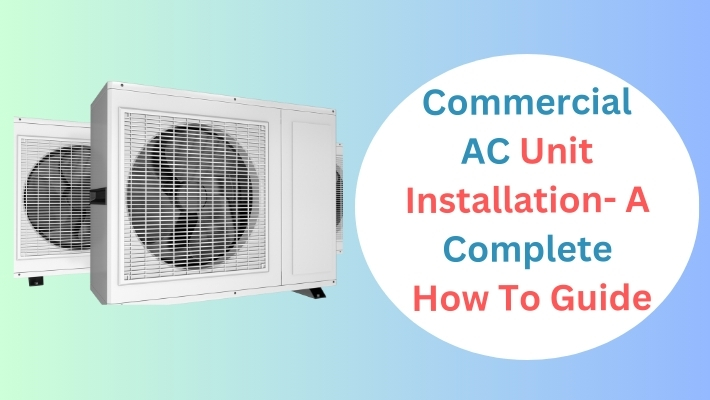
A commercial AC installation is a big task that requires accuracy, experience, and careful preparation. Understanding problems in commercial AC unit installation is essential. Whether you’re a facilities manager or a business owner, this understanding can help you increase the lifespan of an AC unit.
This blog tends to lead you through each stage of the procedure, from choosing the appropriate device to installation and maintenance. Now let’s get started and learn how to properly install commercial air conditioning equipment to maintain a cool, productive workplace.
Preparing for Installation
Assessing Your Needs
Finding out your unique cooling needs is essential before beginning the installation process. The first step is to choose the right kind and size of air conditioning equipment. Units that are either too big or too small might be inefficient and more expensive.
First, figure out how much-cooling power and load your area will require, considering building layout, square footage, and heat-producing appliances. Precise load estimates guarantee that the selected unit will operate at peak efficiency and productivity.
Budgeting and Planning
Planning and budgeting correctly are crucial to preventing unforeseen costs and delays. Start by calculating the overall expenses, taking into account the cost of the AC unit, installation charges, and continuing upkeep.
Getting detailed quotations from the right HVAC system providers is crucial to understanding the financial commitment. Furthermore, give careful thought to the installation schedule.
To reduce disturbances and guarantee a more seamless procedure, it is advisable to arrange the installation during off-peak business hours or seasons.
Choosing The Right AC Unit
It’s critical to choose the appropriate commercial Commercial AC Unit Installation type to satisfy your unique cooling requirements. Depending on the application, common choices include rooftop units, split systems, and central air conditioning.
Each has advantages. Examine the unit’s SEER (Seasonal Energy Efficiency Ratio) rating to see its efficiency. The higher SEER ratings correspond to greater efficiency and lower operating expenses.
To make an informed choice, compare several brands and models while considering features like warranty, support services, and dependability. Carefully evaluate your requirements, make an efficient budget, and select the ideal indoor unit.
Then lay the groundwork for an installation that will guarantee a productive and comfortable workplace.
Pre-Installation Steps
Site inspection and planning
A complete site examination and preparation are necessary before starting the installation of business air conditioning units. Evaluate the AC unit installation site, which should be accessible for air conditioning service and repair.
Make sure that the ventilation is adequate to provide effective airflow and keep the machine from overheating. Verify that there is enough room at the location for the unit and any ductwork that may be required.
Assess any structural issues as well, such as the requirement for reinforcement to handle the weight of the air conditioning unit, and alter the building’s construction if needed.
Obtaining The Required Licences
It is essential to understand building rules and local regulations during the installation process. To make sure that all legal criteria are met, find out what exactly your area requires. This frequently entails abiding by environmental laws, safety standards, and particular requirements for a commercial building.
Once you fully understand these conditions, submit the required permission applications together with comprehensive supporting documents. This should include site drawings and the AC unit’s technical specifications. By taking this step, you can make sure that your installation project complies with the law and prevent any fines or delays.
Process of Commercial AC Unit Installation
Positioning of AC Unit
The longevity and efficiency of your business air conditioning unit depend greatly on where you choose to put it. Select a location that gets enough ventilation, is free of obstacles, and has direct sunshine.
Assure convenient access for upkeep and repairs. Once the location has been established, attach the unit firmly using the necessary bolts and supports to stop any movement or vibrations.
Electrical Component Connectors
For safe functioning, the AC unit must be wired correctly to the building’s power source. As you attach the unit, make sure all electrical connections are tight and secure according to the manufacturer’s recommendations. Install disconnects and breakers to give people a way to safely turn off the electricity in case of emergencies or maintenance.
Configuring the Ductwork
Creating an effective duct architecture is essential for the best possible cooling and airflow. Reduce the number of turns and obstacles in the layout. Make sure that the supply and return ducts are installed appropriately for the unit’s capacity. To stop air leaks, seal all duct joints and connections. Insulate the ducts to keep the temperature under control.
Installation of Refrigerant Lines
Refrigerant line connections must be made precisely to prevent leaks and guarantee efficiency. Refer to the manufacturer’s specifications for the proper size and type of refrigerant lines. Once the lines are connected, use the necessary leak detection techniques to check for leaks and make sure the insulation is enough to stop condensation and energy loss.
Installation and Configuration of Thermostats
To guarantee reliable readings, position the thermostat in the middle of the room, away from heat sources and direct sunlight. Configure the thermostat’s settings for best results and wire it to the unit’s specifications. This can be energy efficient and help maintain an indoor temperature.
Maintenance and Troubleshooting
Routine Maintenance Tasks
Maintaining an efficient commercial air conditioning system requires routine maintenance, particularly in areas like Daytona Beach where the environment necessitates a reliable cooling unit.
To ensure the best possible flow and air quality, start by inspecting and replacing your air filters once a month. Every three months, clean the condenser and evaporator coils to avoid dust and debris accumulation, which can reduce efficiency. Check and top off the refrigerant levels to make sure the system cools efficiently.
Maintain the drain lines regularly to avoid blockages and water damage. The possibility of needing a commercial AC replacement in Daytona Beach can be reduced by scheduling professional inspections. This can help in identifying such concerns at an early stage.
Common Issues and Solutions
Even with regular maintenance, commercial AC units can encounter various issues. Leaking refrigerant is a common problem that can reduce cooling efficiency. It’s crucial to locate and fix leaks quickly. Short cycling, where the unit frequently turns on and off, can be caused by thermostat issues in a split system.
Dirty filters and coils can lead to poor airflow, which can be easily solved by regular cleaning. Unusual noises might indicate loose parts or motor issues, requiring immediate attention to prevent further damage. A malfunctioning economizer can affect energy costs by minimizing efficiency, which is often rectified by recalibrating or replacing faulty components.
Conclusion
To guarantee a comfortable and productive workspace, installing commercial HVAC systems requires precise planning and execution. By hiring a professional, you can get the most out of your unit and extend its lifespan.
To ensure a dependable cooling system for your company, seeking professional advice on indoor or outdoor unit installation is important.








